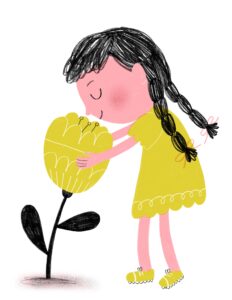 Breathing Techniques for Anxiety
Breathing Techniques for Anxiety
Anxiety is a common experience for kids, teens, and adults. While teens and adults can usually talk about their concerns, kids sometimes have trouble recognizing and naming emotional states and may show anxiety through their bodies instead. Worry and anxiety can cause lots of unpleasant symptoms in the body such as fast heartbeat, shallow breathing, sweating, sore or weak muscles, headache, and stomachache.
Parents can help kids and teens to manage anxiety using a quick and simple technique: controlled breathing. Deliberate breathing counteracts many of the body-based effects of anxiety and helps the nervous system to more quickly return to normal functioning. Here are three breathing exercises to try with your child.
- Flower-candle breathing
In this exercise, you and your child will imagine two scenarios to help you breathe deeply and bring extra oxygen into the body. On the inhale, imagine that you are holding a favorite flower to your nose and deeply inhaling the scent. On the exhale, imagine that you are blowing out candles on a large birthday cake. Blow out all the air in your lungs to make sure you get all the candles! Repeat 5-10 times.
- Calm breathing
In this exercise, you and your child will regulate the length of your breath and bring order and calm to your body. Breathe in through the nose for a count of 4- hold the breath for a count of 4- breathe out through the nose or mouth for a count of 4. Repeat as many times as desired.
- Balloon breathing
In this exercise, you and your child will practice filling and emptying the diaphragm to ensure deep, even breathing. Pretend that your stomach is a balloon and you’re going to fill it up with air. Because you’re trying to make the balloon as big as possible, all the air should go to the balloon- the chest should not be moving. Breathe in through the nose and “blow up the balloon” as much as you can, then breathe out through the nose or mouth to “deflate the balloon”. Get out as much air as you can before starting to blow up the balloon again! Repeat 5-10 times.
You can also practice this skill while lying down. Put a stuffed animal, one hand, or other light item on the child’s stomach so he or she can watch the animal move with each inhale and exhale.
As you learn and practice these exercises, help your child to notice changes in his or her body before and after regulated breathing. Did her heartbeat slow down? Did his muscles relax? Praise your child for trying something new and encourage him or her to use these strategies in any situation that could use some extra calm. Model using the strategies yourself and encourage your child to join you.
If your child’s anxiety is so intense that it interferes with daily functioning at home, at school, with peers, or in other activities, it’s a good idea to seek professional help. An effective therapist can help your child learn new ways of thinking and behaving that will reduce anxiety and increase healthy ways of coping. If you’re not quite ready to make an appointment for your child, set a timetable for when you and your parenting partner(s) will talk about the issue again. Keep track of the issues you’re concerned about and you’ll have more data available when you revisit the subject.
I hope these exercises bring calm and peace to your family!
Many thanks to our guest blogger:
Sara Hofmann PhD.
Post-Doctoral Psychologist
Parent & Child Psychological Services
941-357-4090
Dr. Hofmann is available this summer on Wednesday mornings at Weiss Pediatric Care for brief consultations. She talks with kids and parents about worries and concerns such as anxiety, sadness, depression, separation issues, and physical symptoms like headaches and stomach aches that may be related to stress and other emotional triggers. Dr. Hofmann provides support and resources…while you’re here in the office, or even by phone during her Wednesday morning Weiss Pediatric Care hours.
